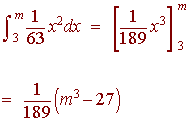Expected Value and Variance
Expected Value
We have seen that for a discrete random variable, that the expected value is the sum of all xP(x). For continuous random variables, P(x) is the probability density function, and integration takes the place of addition.
|
Definition of Expected Value Let f(x) be a probability density function on the domain [a,b], then the expected value of f(x) is
|
Remark: Integration by parts and/or substitution will typically be used to perform the integration.
Example
Find the expected value of the density function defined by
f(x) = sin(x) 0 < x < p/2
Solution
We compute the integral
![]()
We use integration by parts with
u = x dv =
sin(x) dx
du = dx
v = -cos(x)
We have

Variance and Standard Deviation
The variance formula for a continuous random variable also follows from the variance formula for a discrete random variable. Once again we interpret the sum as an integral.
|
Definition of Variance and Standard Deviation Let f(x) be a probability density function on the domain [a,b], then the variance of f(x) is
and the standard deviation is the square root of the variance.
|
Example
Use a calculator to find the variance and standard deviation of the density function
f(x) = 6x - 6x2 0 < x < 1
Solution
We first need to find the expected value. We have
![]()
Now we can compute the variance

Finally the standard deviation is the square root of the variance or
s = 0.22
The Median
The expected value is what you are used to as the average. Another useful number is the median which gives the halfway point. Since the total area under a probability density function is always equal to one, the halfway point of the data will be the x-value such that the area from the left to the median under f(x) is equal to 1/2.
|
Definition of the Median Let f(x) be a probability density function on the domain [a,b], then the median of f(x) is the unique number m between a and b such that
|
Example
Find the median of the probability density function
1
f(x) =
x2 3 < x <
6
63
Solution
We integrate

Now we set the above equal to 1/2 and solve.
![]()
m3
- 27 = 94.5
m3 = 121.5
m = 4.95
The Uniform Density Function
If every interval of a fixed length is equally likely to occur then we call the probability density function the uniform density function. It has formula
1
f(x) =
a < x < b
b - a
Example
The distribution of insects along a fallen log of length twenty feet is uniform. Find the standard deviation for this distribution.
Solution
First notice that the density function is given by
1
f(x) =
0 < x <
20
20
The expected value is given by

Next, we find the variance. We have

The standard deviation is the square root
s = 5.77
The Normal Distribution
The most important distribution for working with statistics is called the normal distribution. If with mean m and standard deviation s the density function is given by

Exercise
Show that the expected value of the normal distribution is m.
The Exponential Distribution
Another important distribution is call the exponential distribution. It has density function
![]()
Exercise
Find the mean and standard deviation of the exponential distribution.
Back to the Math 117 Home Page
Back to the Math Department Home
e-mail Questions and Suggestions

